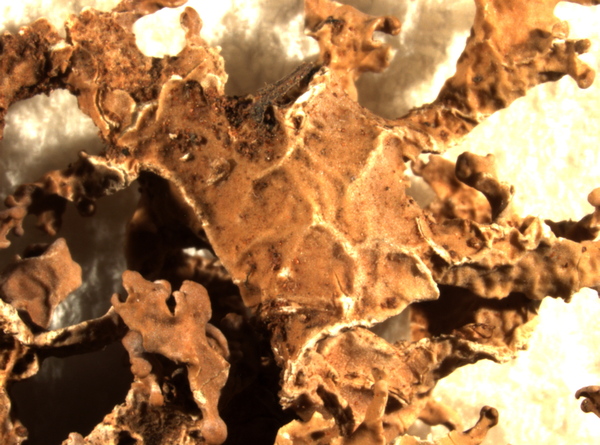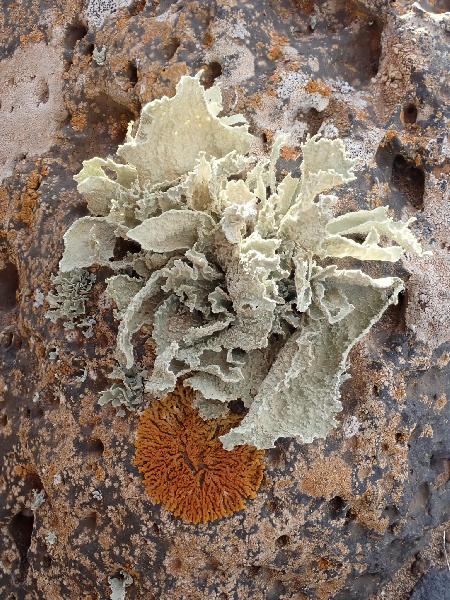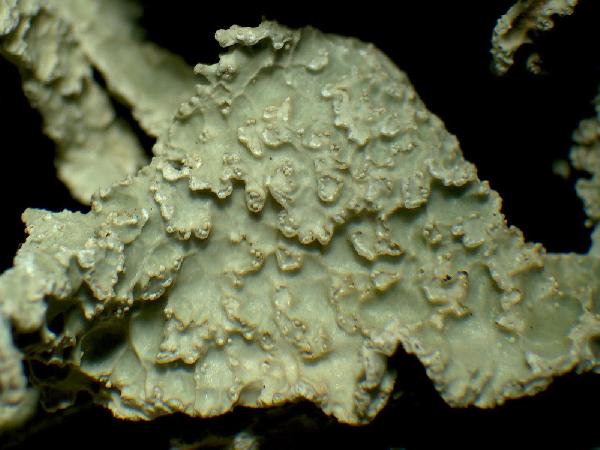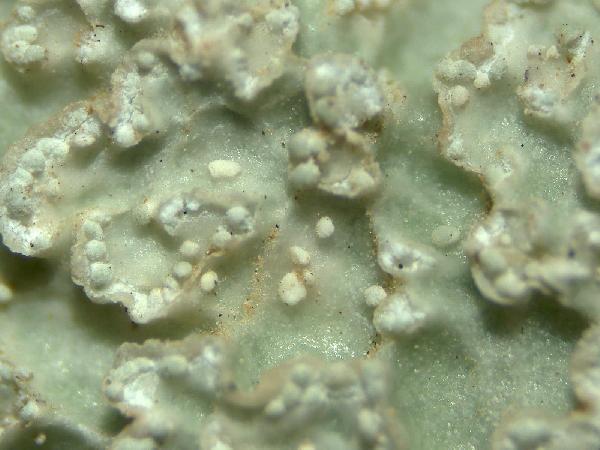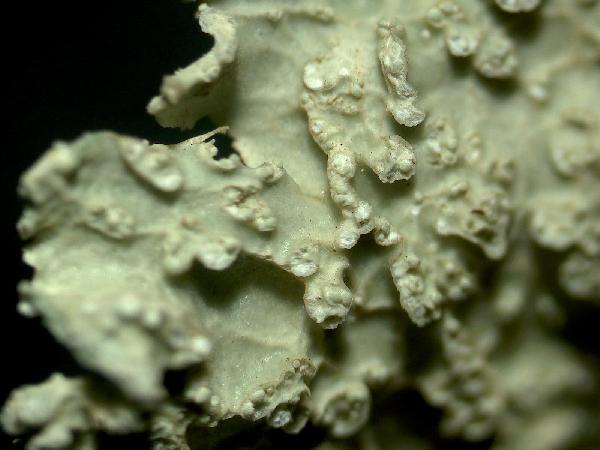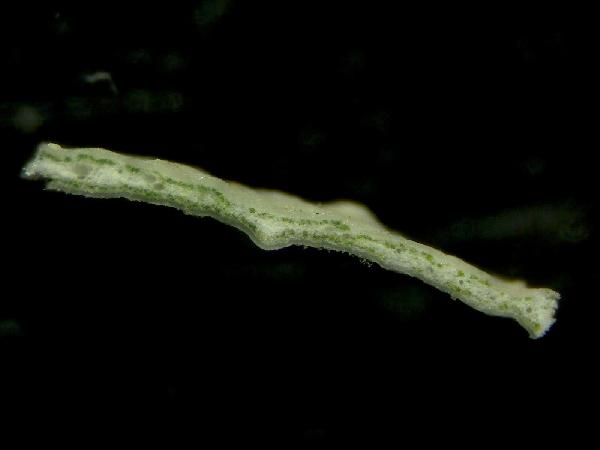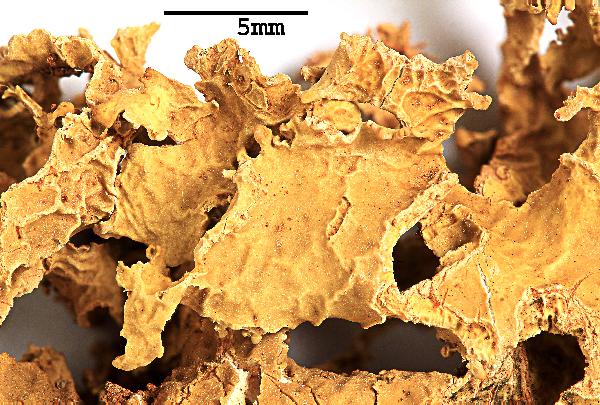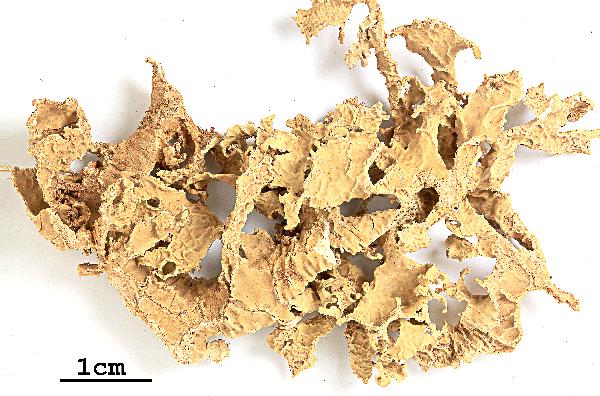Ramalina maciformis (Delile) Bory
Dict. Class. Hist. Nat., 14: 458, 1828. Basionym: Parmelia maciformis Delile - Descr. Egypte: 144, 1813.
Synonyms: Niebla maciformis (Delile) Rundel & Bowler; Ramalina evernioides Nyl. non auct.
Distribution: C - Tosc, Sar (TSB 37555). S - Bas, Si (Ottonello & Romano 1997).
Description: Thallus fruticose, consisting of yellowish green to greenish grey, 1-6 cm long, 0.2-4(-6) cm wide, rigid, erect, in part reticulately ridged, simple or sparingly branched laciniae from a basal holdfast, with an irregular network of large cracks exposing the medullary layer, from which granular soredia (or schizidioid isidia) originate. Cortex 50-75 pm thick, the chondroid cylinder absent; medulla dense, with imbedded strands of chondroid tissue. Apothecia extremely rare (not observed in Italian material). Photobiont chlorococcoid. Spot tests: cortex K-, C-, KC- or KC+ pale yellow, P-; medulla and ‘soralia’ K- or K+ orange-red, C-, KC-, P- or P+ yellow to orange. Chemistry: cortex with usnic acid; medulla with bourgeanic acid, plus salazinic or norstictic acids.Note: a Mediterranean species of coastal siliceous rocks, probably occurring also in other small islands of Southern Italy.
Growth form: Fruticose
Substrata: rocks
Photobiont: green algae other than Trentepohlia
Reproductive strategy: mainly asexual, by soredia, or soredia-like structures (e.g. blastidia)
Taxon bound to maritime-coastal situations
Commonnes-rarity: (info)
Alpine belt: absent
Subalpine belt: absent
Oromediterranean belt: absent
Montane belt: absent
Submediterranean belt: absent
Padanian area: absent
Humid submediterranean belt: absent
Humid mediterranean belt: very rare
Dry mediterranean belt: very rare

Predictive model
Herbarium samples
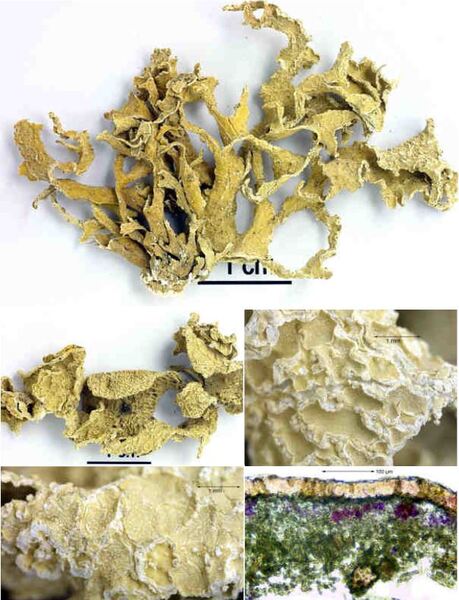

Felix Schumm – CC BY-SA 4.0
Image from: F. Schumm (2008) - Flechten Madeiras, der Kanaren und Azoren. Beck, OHG - ISBN: 978-3-00-023700-3
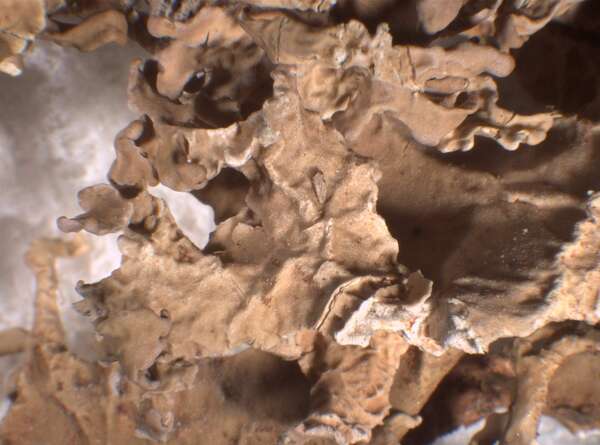

P.L. Nimis; Owner: Department of Life Sciences, University of Trieste
Herbarium: TSB (9129)
2002/12/02
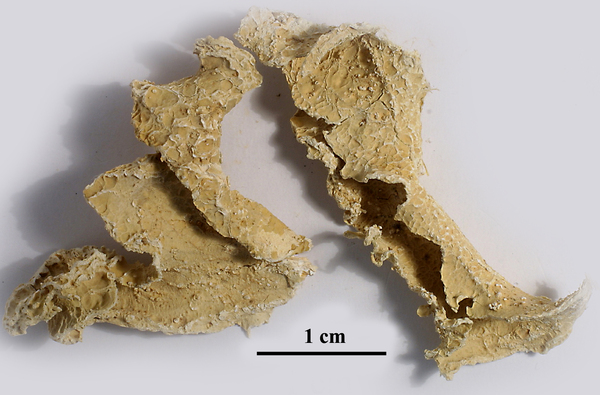
Felix Schumm - CC BY-SA 4.0
[2487], Südisrael, Negev Wüste: gesellig an licht- und windoffenen Hornsteinknollen im Caloplacetum ehrenbergii, 550 m, NO-NW, pH 6,6 in der Umgebung des Avdat Farm and Desert Research Center of the Hebrew University of Jerusalem. Leg. O. L. Lange 09.1967, conf. G. Follmann 01.1967. FOLLMANN: LICH. EXS. SEL. 186
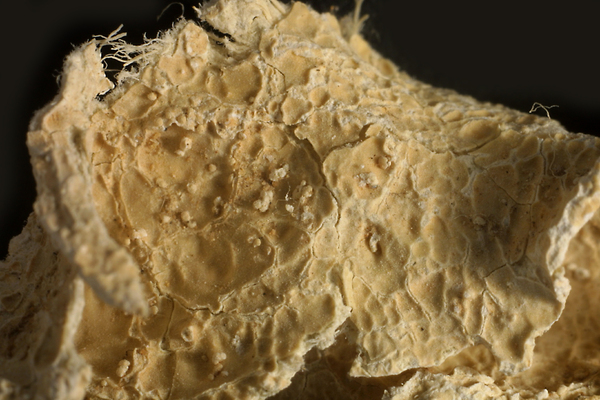
Felix Schumm - CC BY-SA 4.0
[2487], Südisrael, Negev Wüste: gesellig an licht- und windoffenen Hornsteinknollen im Caloplacetum ehrenbergii, 550 m, NO-NW, pH 6,6 in der Umgebung des Avdat Farm and Desert Research Center of the Hebrew University of Jerusalem. Leg. O. L. Lange 09.1967, conf. G. Follmann 01.1967. FOLLMANN: LICH. EXS. SEL. 186
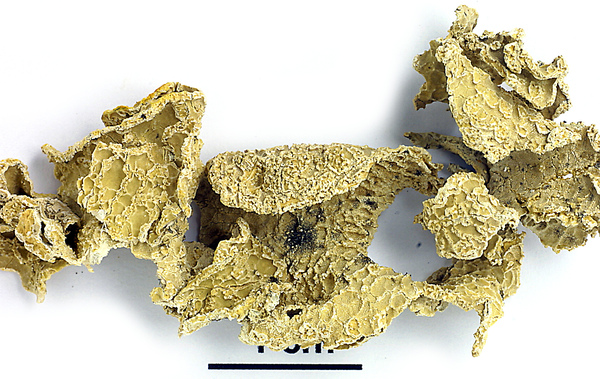
Felix Schumm - CC BY-SA 4.0
[3046], Israel, Ha-Negev. Avedat. An Kalkblöcken bei den Ruinen. Xero- photophil. Windschliff ausgesetzt, sehr trocken, ca 600 m. Leg. F. Schumm, 30.12.1984, conf. A. Aptroot 05.2006
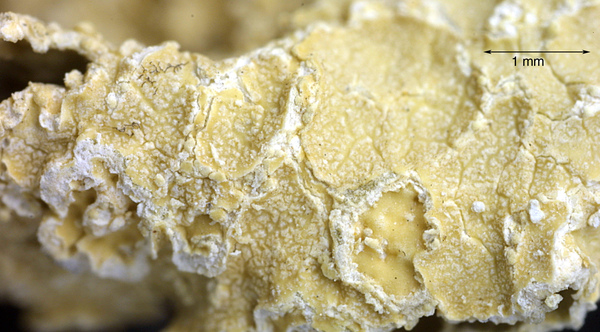
Felix Schumm - CC BY-SA 4.0
[3046], Israel, Ha-Negev. Avedat. An Kalkblöcken bei den Ruinen. Xero- photophil. Windschliff ausgesetzt, sehr trocken, ca 600 m. Leg. F. Schumm, 30.12.1984, conf. A. Aptroot 05.2006

Felix Schumm - CC BY-SA 4.0
[3046], Israel, Ha-Negev. Avedat. An Kalkblöcken bei den Ruinen. Xero- photophil. Windschliff ausgesetzt, sehr trocken, ca 600 m. Leg. F. Schumm, 30.12.1984, conf. A. Aptroot 05.2006
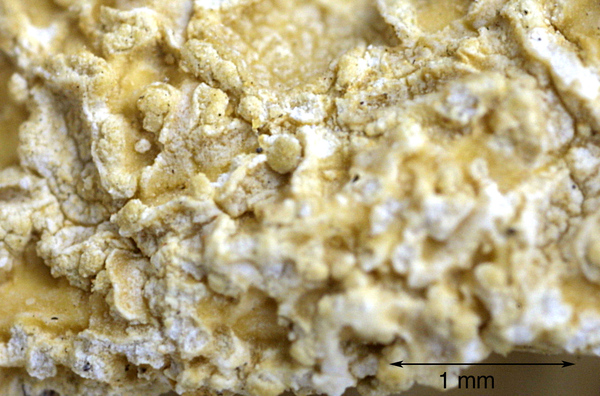
Felix Schumm - CC BY-SA 4.0
[3046], Israel, Ha-Negev. Avedat. An Kalkblöcken bei den Ruinen. Xero- photophil. Windschliff ausgesetzt, sehr trocken, ca 600 m. Leg. F. Schumm, 30.12.1984, conf. A. Aptroot 05.2006
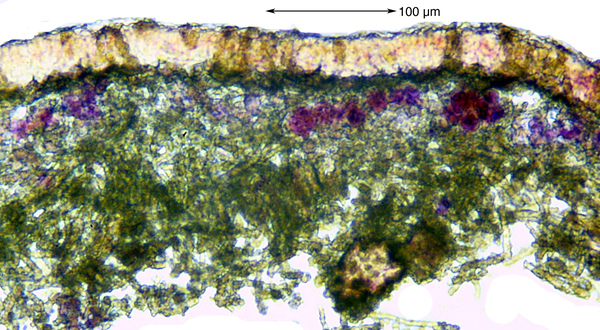
Felix Schumm - CC BY-SA 4.0
[3046], Israel, Ha-Negev. Avedat. An Kalkblöcken bei den Ruinen. Xero- photophil. Windschliff ausgesetzt, sehr trocken, ca 600 m. Leg. F. Schumm, 30.12.1984, conf. A. Aptroot 05.2006
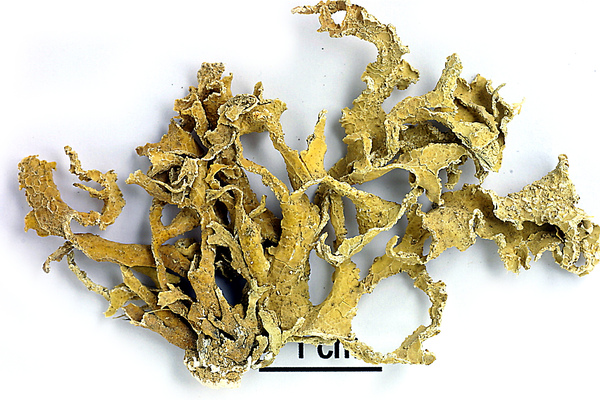
Felix Schumm - CC BY-SA 4.0
[3046], Israel, Ha-Negev. Avedat. An Kalkblöcken bei den Ruinen. Xero- photophil. Windschliff ausgesetzt, sehr trocken, ca 600 m. Leg. F. Schumm, 30.12.1984, conf. A. Aptroot 05.2006
Growth form: Fruticose
Substrata: rocks
Photobiont: green algae other than Trentepohlia
Reproductive strategy: mainly asexual, by soredia, or soredia-like structures (e.g. blastidia)
Taxon bound to maritime-coastal situations
Commonnes-rarity: (info)
Alpine belt: absent
Subalpine belt: absent
Oromediterranean belt: absent
Montane belt: absent
Submediterranean belt: absent
Padanian area: absent
Humid submediterranean belt: absent
Humid mediterranean belt: very rare
Dry mediterranean belt: very rare

Predictive model
| Herbarium samples |


Felix Schumm – CC BY-SA 4.0
Image from: F. Schumm (2008) - Flechten Madeiras, der Kanaren und Azoren. Beck, OHG - ISBN: 978-3-00-023700-3


P.L. Nimis; Owner: Department of Life Sciences, University of Trieste
Herbarium: TSB (9129)
2002/12/02

Felix Schumm - CC BY-SA 4.0
[2487], Südisrael, Negev Wüste: gesellig an licht- und windoffenen Hornsteinknollen im Caloplacetum ehrenbergii, 550 m, NO-NW, pH 6,6 in der Umgebung des Avdat Farm and Desert Research Center of the Hebrew University of Jerusalem. Leg. O. L. Lange 09.1967, conf. G. Follmann 01.1967. FOLLMANN: LICH. EXS. SEL. 186

Felix Schumm - CC BY-SA 4.0
[2487], Südisrael, Negev Wüste: gesellig an licht- und windoffenen Hornsteinknollen im Caloplacetum ehrenbergii, 550 m, NO-NW, pH 6,6 in der Umgebung des Avdat Farm and Desert Research Center of the Hebrew University of Jerusalem. Leg. O. L. Lange 09.1967, conf. G. Follmann 01.1967. FOLLMANN: LICH. EXS. SEL. 186

Felix Schumm - CC BY-SA 4.0
[3046], Israel, Ha-Negev. Avedat. An Kalkblöcken bei den Ruinen. Xero- photophil. Windschliff ausgesetzt, sehr trocken, ca 600 m. Leg. F. Schumm, 30.12.1984, conf. A. Aptroot 05.2006

Felix Schumm - CC BY-SA 4.0
[3046], Israel, Ha-Negev. Avedat. An Kalkblöcken bei den Ruinen. Xero- photophil. Windschliff ausgesetzt, sehr trocken, ca 600 m. Leg. F. Schumm, 30.12.1984, conf. A. Aptroot 05.2006

Felix Schumm - CC BY-SA 4.0
[3046], Israel, Ha-Negev. Avedat. An Kalkblöcken bei den Ruinen. Xero- photophil. Windschliff ausgesetzt, sehr trocken, ca 600 m. Leg. F. Schumm, 30.12.1984, conf. A. Aptroot 05.2006

Felix Schumm - CC BY-SA 4.0
[3046], Israel, Ha-Negev. Avedat. An Kalkblöcken bei den Ruinen. Xero- photophil. Windschliff ausgesetzt, sehr trocken, ca 600 m. Leg. F. Schumm, 30.12.1984, conf. A. Aptroot 05.2006

Felix Schumm - CC BY-SA 4.0
[3046], Israel, Ha-Negev. Avedat. An Kalkblöcken bei den Ruinen. Xero- photophil. Windschliff ausgesetzt, sehr trocken, ca 600 m. Leg. F. Schumm, 30.12.1984, conf. A. Aptroot 05.2006

